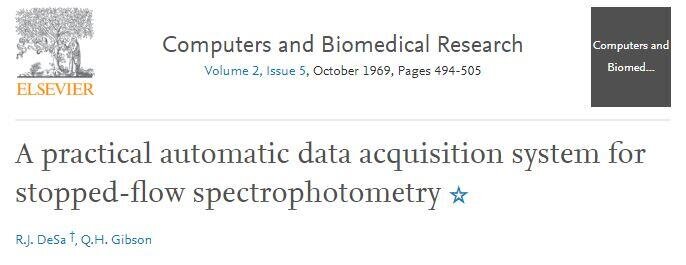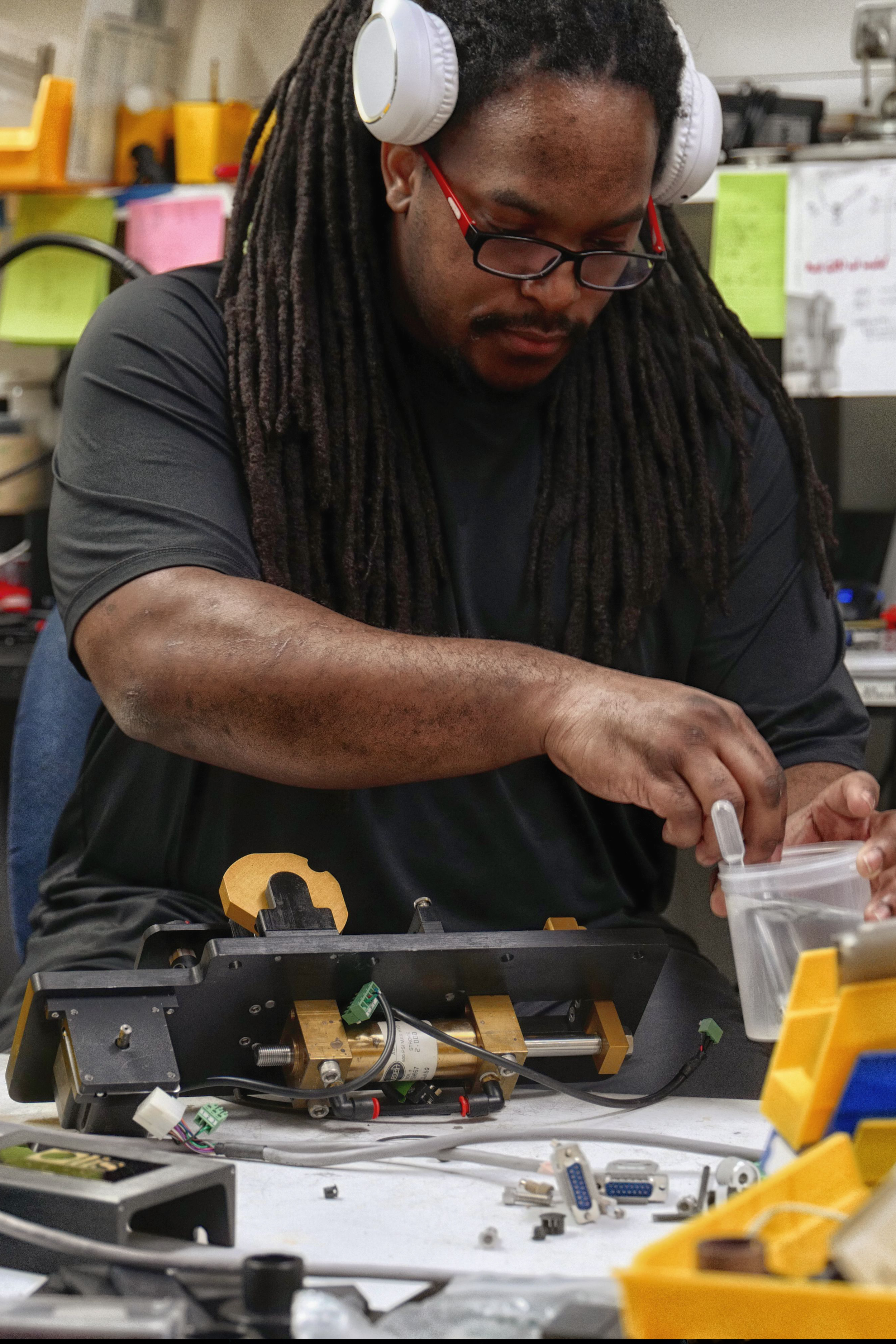Not known Factual Statements About Uv/vis/nir
Table of ContentsThe Best Strategy To Use For SpectrophotometersLittle Known Questions About Circular Dichroism.Fascination About Circular DichroismThe smart Trick of Uv/vis/nir That Nobody is DiscussingThe Best Strategy To Use For SpectrophotometersAll about Uv/vis/nirThe Greatest Guide To Uv/vis/nirSome Ideas on Uv/vis/nir You Should KnowFascination About SpectrophotometersThe Buzz on Circular DichroismGet This Report about Spectrophotometers6 Easy Facts About Spectrophotometers ShownCircular Dichroism Fundamentals Explained
It is then scanned through the sample and the referral solutions. Fractions of the incident wavelengths are transmitted through, or shown from, the sample and the recommendation. The resultant light strikes the photodetector device, which compares the relative strength of the two beams. Electronic circuits transform the relative currents into linear transmission portions and/or absorbance/concentration values.The transmission of a referral compound is set as a baseline (information) value, so the transmission of all other compounds are taped relative to the preliminary "zeroed" compound. The spectrophotometer then transforms the transmission ratio into 'absorbency', the concentration of particular elements of the test sample relative to the preliminary compound.
Considering that samples in these applications are not easily offered in large amounts, they are specifically matched to being analyzed in this non-destructive technique. In addition, precious sample can be conserved by using a micro-volume platform where as little as 1u, L of sample is needed for total analyses. A quick description of the treatment of spectrophotometry includes comparing the absorbency of a blank sample that does not include a colored substance to a sample that contains a colored substance.
Indicators on Circularly Polarized Luminescence You Should Know
In biochemical experiments, a chemical and/or physical residential or commercial property is selected and the treatment that is utilized specifies to that residential or commercial property in order to obtain more info about the sample, such as the quantity, purity, enzyme activity, and so on. Spectrophotometry can be utilized for a variety of strategies such as identifying optimum wavelength absorbance of samples, identifying ideal p, H for absorbance of samples, identifying concentrations of unidentified samples, and figuring out the p, Ka of numerous samples.: 21119 Spectrophotometry is also a helpful procedure for protein purification and can also be used as a technique to produce optical assays of a substance.
It is possible to know the concentrations of a 2 element mixture using the absorption spectra of the basic services of each element. To do this, it is necessary to know the termination coefficient of this mixture at 2 wave lengths and the extinction coefficients of options which contain the known weights of the two parts.

The Of Circular Dichroism
Region. The concentration of a protein can be approximated by measuring the OD at 280 nm due to the presence of tryptophan, tyrosine and phenylalanine.
Nucleic acid contamination can likewise interfere. This method needs a spectrophotometer capable of determining in the UV region with quartz cuvettes.: 135 Ultraviolet-visible (UV-vis) spectroscopy includes energy levels that excite electronic shifts. Absorption of UV-vis light thrills particles that are in ground-states to their excited-states. Visible region 400700 nm spectrophotometry is used extensively in colorimetry science.
These curves can be used to check a new batch of colorant to check if it makes a match to specifications, e
Traditional visible standard spectrophotometers can not detect if discover colorant or the base material has fluorescence. This can make it tough to manage color concerns if for example one or more of the printing inks is fluorescent. There are 2 major setups for visual spectrum spectrophotometers, d/8 (spherical) and 0/45.
Scientists utilize this instrument to determine the quantity of compounds in a sample. If the substance is more concentrated more light will be soaked up by the sample; within little varieties, the Beer, Lambert law holds and the absorbance between samples vary with concentration linearly. When it comes to printing measurements 2 alternative settings are frequently utilized- without/with uv filter to control much better the effect of uv brighteners within the click now paper stock.
Fascination About Spectrophotometers
Some applications need small volume measurements which can be carried out with micro-volume platforms. As described in the applications area, spectrophotometry can be utilized in both qualitative and quantitative analysis of DNA, RNA, and proteins. Qualitative analysis can be used and spectrophotometers are utilized to record spectra of substances by scanning broad wavelength regions to determine the absorbance residential or commercial properties (the strength of the color) of the compound at each wavelength.

All About Circularly Polarized Luminescence
One major factor is the type of photosensors that are available for various spectral areas, but infrared measurement is likewise challenging due to the fact that virtually whatever produces IR as thermal radiation, particularly at wavelengths beyond about 5 m. Another complication is that many products such as glass and plastic absorb infrared, making it incompatible as an optical medium.
2013. p. 13. Allen, DW; Cooksey, C; Tsai, BK (Nov 13, 2009). "Spectrophotometry". Obtained Dec 23, 2018. Ninfa AJ, Ballou DP, Benore M (2010 ). Fundamental Lab Approaches for Biochemistry and Biotechnology (second ed.). Hoboken: Wiley & Sons. ISBN 9780470087664. OCLC 488246403. Schwedt G (1997 ). The vital guide to analytical chemistry.
Oke, J. B.; Gunn, J. E.
The Facts About Uv/vis Uncovered

Ninfa AJ, Ballou DP, Benore M (2015 ). Essential Lab Techniques for Biochemistry and Biotechnology (3, rev. ed.). UV/Vis. Laboratory Equipment.
The Best Strategy To Use For Uv/vis
Recovered Jul 4, 2018. Trumbo, Toni A.; Schultz, Emeric; Borland, Michael G.; Pugh, Michael Eugene (April 27, 2013). "Applied Spectrophotometry: Analysis of a Biochemical Mixture". Biochemistry and Molecular Biology Education. 41 (4 ): 24250. doi:10. 1002/bmb. 20694. PMID 23625877. (PDF). www. mt.com. Mettler-Toledo AG, Analytical. 2016. Obtained Dec 23, 2018. Cortez, C.; Szepaniuk, A.; Gomes da Silva, L.
"Checking Out Proteins Filtration Strategies Animations as Tools for the Biochemistry Mentor". Journal of Biochemistry Education. 8 (2 ): 12. doi:. Garrett RH, Grisham CM (2013 ). Biochemistry. Belmont, CA: Cengage. p. 106. ISBN 978-1133106296. OCLC 801650341. Holiday, Ensor Roslyn (May 27, 1936). "Spectrophotometry of proteins". Biochemical Journal. 30 (10 ): 17951803. doi:10. 1042/bj0301795.
PMID 16746224. Hermannsson, Ptur G.; Vannahme, Christoph; Smith, Cameron L. C.; Srensen, Kristian T.; Kristensen, Anders (2015 ). "Refractive index dispersion noticing using a selection of photonic crystal resonant reflectors". Applied Physics Letters. 107 (6 ): 061101. Bibcode:2015 Ap, Ph, L. 107f1101H. doi:10. 1063/1. 4928548. S2CID 62897708. Mavrodineanu R, Schultz JI, Menis O, eds.
The Definitive Guide for Spectrophotometers
U.S. Department of Commerce National Bureau of Standards special publication; 378. Washington, D.C.: U.S. National Bureau of Standards. p. 2. OCLC 920079.
The process starts with a controlled light that illuminates the examined sample. When it comes to reflection, as this light engages with the sample, some is soaked up or discharged. The discharged light travels to the detector, which is analyzed, quantified, and provided as industry-standard color scales and indices.
Market governing bodies usually define specific metrics for particular items, such as Tomato and Coffee indices. The simplified mathematics appears like this: Where R is the reflection coefficient. All terms are examined over the noticeable spectrum from 400 to 700 nm. When it comes to transmission, when the light interacts with the sample, it is either soaked up, shown, or transferred.
The smart Trick of Circular Dichroism That Nobody is Discussing
Examples include APHA (American Public Health Association) for watercolor and pureness analysis, ASTM D1500 for petrochemical color analysis, edible oil indices utilized in food, and color analyses of drinks. The streamlined math looks like this:. Where T is the transmission coefficient. All terms are examined over the visible spectrum from 400 to 700 nm.
Image Credit: Matej Kastelic/ Dr. Arnold J. Beckman and his associates at the National Technologies Laboratories first created the spectrophotometer in 1940. In 1935 Beckman founded the company, and the discovery of the spectrophotometer was their most ground-breaking innovation. Dr. Bruce Merrifield, a Nobel prize-winning biochemist, stated that the creation of the spectrophotometer was "probably the most essential instrument ever developed towards the improvement of bioscience." Before the discovery of the spectrophotometer, chemical analyses took weeks to finish, with 25% precision.
What Does Circular Dichroism Mean?
Over time, scientists kept enhancing the spectrophotometer style to boost its efficiency. The UV capabilities of the model B spectrophotometer were enhanced by replacing the glass prism with a quartz prism.
Normally, a spectrophotometer is made up of 2 instruments, particularly, a spectrometer and a photometer. A basic spectrophotometer contains a light source, a monochromator, a collimator for straight light beam transmission, a cuvette to position a sample, and a photoelectric detector.
Circularly Polarized Luminescence Can Be Fun For Anyone
There are different kinds of spectrophotometers in numerous shapes and sizes, each with its own purpose or functionality. A spectrophotometer determines how much light is reflected by chemical elements. circularly polarized luminescence. It determines the difference in light strength based on the total amount of light presented to a sample and the quantity of light beam that passes through the sample option
A spectrophotometer is utilized to figure out the concentration of both colorless and colored solutes in a service. This instrument is utilized to identify the rate of a response.